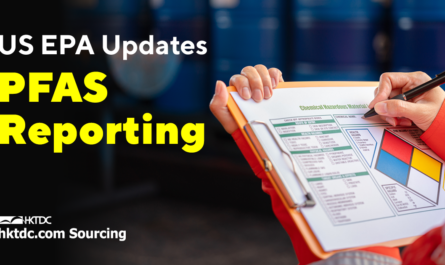Chances are that your product contains PFAS and PFCA! Restrictions are already in place. Some additional restrictions will come into effect early next year. PFAS are used in a wide variety of consumer products because of their unique chemical and physical properties. Examples of these properties are oil and water repellence, temperature and chemical resistance, and surfactant properties. PFAS are used in many products, e.g. firefighting foams, non-stick metal coatings for frying pans, paper food packaging, creams and cosmetics, textiles for furniture and clothing, paints, coating, varnishes, chrome plating and preservatives. Check if your products are affected!

What are poly- and perfluoroalkyl substances (PFAS)?
PFAS stands for poly- and perfluoroalkyl substances. This is a large family of chemical substances which comprises more than 6,000 substances. PFAS are controversial because they are hazardous for human health and the environment. Due to new scientific insights certain chemicals belonging to the PFAS family are included in the REACH candidate list for authorisation as a SVHC.

Perfluoroalkyl carboxylic acids (PFCAs), or perfluorocarboxylic acids consist of a wide variety of substances.
Around 200 PFCAs are also belonging to the PFAS family. E.g. PFOA and PFNA are both a PFAS and a PFCA.
A certain amount of the PFCA precursor will remain as a residue in the final PFAS.
So if your product is coated or treated with a PHAS, it will also contain a PFCA.
There are thousands of PFCA-substances with a certain similar chemical composition that may be present in your products. Products that you place on the market after February 25, 2023 may not contain any of those PFCAs. This is regulated in the REACH restriction list under entry 68.
Six PFCAs are also listed in the REACH candidate list as a SVHC;
Alternatives for PFAS

Although all PFAS are controversial are not all PFAS substances restricted. It is expected that more and more PFAS substances will be added to the REACH candidate list in the near future. Seeking for PFAS alternatives is a must. You can divide the PFAS applications in consumer products in three major categories.
- Non-essential (deceptive marketing – mainly used in cosmetics)
- Substitutable
- Essential for which alternative PFAS substances have not yet been developed.
Most PFAS substances in your consumer products will belong to category 2. Teflon (PTFE) is a typical example of a PFAS for which exist many alternatives.
For more information regarding substitutable hazardous chemicals in general, please consult the ChemSec SIN list (substitute it now).
See also the compliance article ‘PFAS in Food Contact Materials’ in ProductIPedia
Disclaimer: This document provides guidance and is not a legally binding interpretation and shall therefore not be relied upon as legal advice.

Caspar ter Horst - Managing Director, ProductIP
Casper has 25+ years of experience in product compliance. In 2008, he co-founded ProductIP together with Maarten van der Dussen. Caspar and his team are dedicated to support companies within the supply chain to efficiently demonstrate to customers, authorities, and users that their products meet applicable legislation and buying requirements. As a result, helping companies reduce costs, streamline operations, manage suppliers, and at the same time put compliant, safer, more sustainable products to the market.
This website may contain material sent to the HKTDC by third parties. Without prejudice to any rights, remedies and interests that HKTDC may have, HKTDC is not responsible for any error, omission or inaccuracy in the material. HKTDC reserves the right to omit, suspend or edit any material submitted. The opinions, findings, conclusions and recommendations expressed in such material are those of the authors thereof, and do not necessarily reflect the views of HKTDC.






















